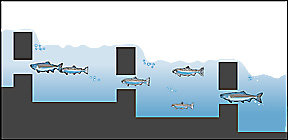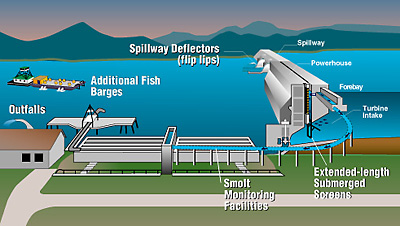The Corps operates a series of eight dams on the lower Columbia and Snake rivers that affect the habitat and migration of anadromous salmon and steelhead species. These are Bonneville, The Dalles, John Day and McNary on the lower Columbia; and Ice Harbor, Lower Monumental, Little Goose and Lower Granite on the lower Snake River. The dams impede juvenile and adult migrations to and from the ocean by their physical presence and by creating reservoirs. The reservoirs behind the dams slow water velocities, alter river temperatures, and increase predation potential. Reduced water velocity increases the time it takes juveniles to migrate downstream, higher water temperatures may have adverse effects on juvenile and adult behavior, and predators find prey more easily in slower-moving water. However, all eight of these dams have juvenile and adult fish passage facilities to enable fish to migrate past the dams; and, the dams are operated to improve passage as well as reservoir conditions for fish.
Adult Fishways at the Dams
 Adult fish ladders at all eight lower Columbia and Snake dams were integrated into the design of the dams beginning with Bonneville in 1938. These ladders consist of a series of steps and pools which provide a gradual upward climb over the dams for returning adults. To steer the adults to the ladders, "attraction" flows at the downstream ladder entrances simulate conditions that would be found at the base of natural waterfalls. The concept has proved effective for adult fish passage.
Adult fish ladders at all eight lower Columbia and Snake dams were integrated into the design of the dams beginning with Bonneville in 1938. These ladders consist of a series of steps and pools which provide a gradual upward climb over the dams for returning adults. To steer the adults to the ladders, "attraction" flows at the downstream ladder entrances simulate conditions that would be found at the base of natural waterfalls. The concept has proved effective for adult fish passage.
Juvenile Fish Passage at the Dams
Currently, juvenile fish can migrate past the dams by several routes: through the turbine; through the juvenile fish bypass system; or over the dam spillway. Some fish are transported past the dams by barge and truck under the juvenile fish transportation program. At The Dalles Dam, fish are bypassed through the ice and trash sluiceway.
Juvenile Fish Bypass System
 The juvenile fish bypass systems in place at the lower Columbia and Snake River dams guide fish away from turbines by means of submerged screens positioned in front of the turbines. The juvenile fish are directed up into a gatewell, where they pass through orifices into channels that run the length of the dam. The fish are then either routed back out to the river below the dam, which is called "bypassing" or, at the four dams with fish transport facilities, fish can be routed to a holding area for loading on specially equipped barges or trucks for transport downriver.
The juvenile fish bypass systems in place at the lower Columbia and Snake River dams guide fish away from turbines by means of submerged screens positioned in front of the turbines. The juvenile fish are directed up into a gatewell, where they pass through orifices into channels that run the length of the dam. The fish are then either routed back out to the river below the dam, which is called "bypassing" or, at the four dams with fish transport facilities, fish can be routed to a holding area for loading on specially equipped barges or trucks for transport downriver.
The juvenile bypass systems guide 80 to 90 percent of steelhead salmon and 60 to 70 percent of spring/summer chinook salmon away from the turbines and upward through the bypass channel. This percentage measure is called fish guidance efficiency, and the rates vary from dam to dam.
Juvenile Fish Transportation Program
Three of the four Snake River dams, and McNary Dam on the Columbia River, have fish transport facilities. At these four dams, juvenile fish that go through the bypass systems can be routed either directly back into the river below the dam, or to holding and loading facilities for loading into barges or trucks for transport. The transport barges and trucks carry the fish past the remaining projects for release below Bonneville dam. River water circulates through the barges allowing the fish to imprint the chemicals and smells of the water during the trip downriver. The barges have a closed-circuit recirculation system which can shut off water intake in case of contamination in the river. They also have pumping systems which can help de-gas the water in areas where gas supersaturation is a problem.
The Corps runs the Juvenile Fish Transportation Program in cooperation with National Marine Fisheries Service, and in accordance with the National Marine Fisheries Service hydropower Biological Opinion for salmon. Fifteen to 20 million salmon and steelhead have typically been transported each year over the past several years. The program has come under criticism in recent years from state and tribal fishery agencies and environmental groups, who believe that rather than putting fish in barges, efforts should concentrate on improving in-river migration conditions.